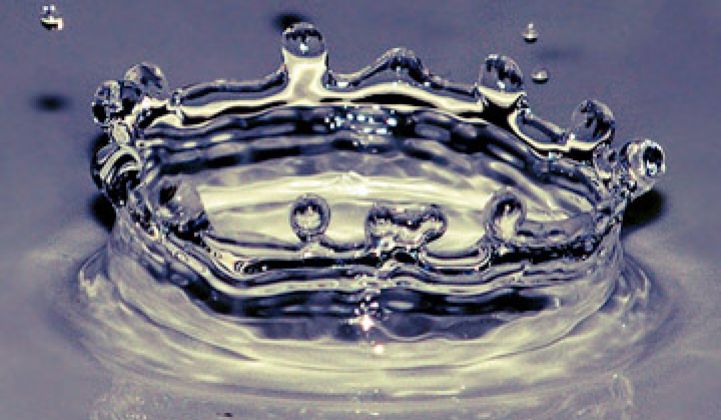WaterSmart, the startup with a cloud-based consumer engagement platform that’s getting water utility customers in California to save up to 5 percent of their water use, has just raised a $4.5 million Series A round to help take its software nationwide.
Tuesday’s funding round brings the San Francisco-based startup’s total investment raised to $6.4 million, including a $900,000 seed round in 2011 and a $1.5 million second seed round in 2012. Existing investors Physic Ventures, Draper Fisher Jurvetson, and Apsara Capital were joined by The Westly Group, which led Tuesday's investment.
WaterSmart CEO and co-founder Peter Yolles said the new funding will go to build up sales and marketing teams and to prepare for a nationwide rollout of its software-as-a-service platform. Much like startup Opower does for electric utility customers, WaterSmart delivers mailed and e-mailed water conservation and bill-reduction tips to customers, manages a web portal to link them to their utilities, and serves as a utility back-office system to manage customer relations and data management and analysis.
“We know that it works,” Yolles said, pointing to results from water districts and city water departments across California that have been using the platform for a year or more, as well as from new municipal utility customers in Texas and in Greeley, Colorado. “We’ve proven demand reduction; we’ve proven an increase in customer engagement.”
Those results include an up to 5 percent reduction in water usage by customers getting the WaterSmart treatment within the first six months of operation, as opposed to customers getting traditional conservation messaging from utilities, he said.
That conservation also comes at a much lower cost than equally effective traditional methods, he added. While WaterSmart’s consumer behavior-change savings come at a cost of about $250 to $500 per acre-foot of water, getting the same reductions through home water audits might cost about $1,200 per acre-foot, he said.
One of WaterSmart’s tricks of the trade is to engage customers by showing them how much water they use compared to neighbors or peers, much like Opower does with energy.
“Encouraging people to be more efficient is about raising awareness around water, and capturing people’s attention is largely about creating this social framework,” he said. “That’s what we create, by creating this home-to-home comparison.”
WaterSmart also gives people a lengthy list of water-conservation options, particularly on outdoor water use, which makes up more than half of total water use for many households, he said. That can range from tips on how to set sprinkler systems to minimize waste, to planting more “water-wise” plants, he said.
At the same time, connecting to customers via reports and web portals can triple the number of customers who request services from their utilities, compared to traditional methods, he said. It’s also led to a doubling of the number of customers giving their water utilities a high ranking in customer satisfaction terms, he said.
These results are being borne out in pilot projects with Northern California’s East Bay Municipal Utility District and the city of Cotati, and are being replicated with its new customers, Southern California’s Irvine Ranch Water District, South Coast Water District and Newport Beach’s municipal utility,
What’s the value in driving efficiency and improving customer relations for water utilities? Well, while water is still cheaper than electricity or natural gas, its cost is also rising at a far faster rate, according to the water-watching nonprofit Circle of Blue.

U.S. residential consumers saw water bills rise an average of 9.4 percent in 30 major metropolitan areas last year, according to Circle of Blue.
Water is also an increasingly scarce and hard-to-obtain commodity across broad swaths of the United States, as well as around the world, as climate change, increasing usage, and contamination put stress on existing supplies. Indeed, utilities are worried about their own water consumption, ranking it along environmental and regulatory uncertainty as a top concern, according to annual surveys from utility engineering and consulting firm Black & Veatch.
While WaterSmart has mainly been noticed for its consumer-facing conservation methods, its back-end platform is an increasingly useful resource for water utilities as well, Yolles said. Most of the country’s water is delivered by public water agencies or cities, which tend to run much older, more proprietary systems than do electric utilities, he said.
Other larger utilities may have more advanced customer information systems, but they’re created for electricity customer management, and aren’t easily used for water consumers, he said. “With WaterSmart, we have a software-as-a-service solution that’s ready to go; it’s basically push-button-ready,” he said. “We combine lots of data into one view, and we create a lot of value for the utility managers.”
It’s also complementary to the new smart water meters that are beginning to be deployed in larger numbers around the country, he added, “because we’re adding value onto the data they’re collecting. We analyze water meter data for leaks, or for errors in the data that might indicate a broken meter, a leak, or something else, so we can make the water managers and utility managers aware of potential problems.”
Beyond the meters, of course, there’s a wider world of IT going into the water utility sector, from cutting-edge, region-wide smart water projects like IBM’s investments in projects in Malta, Australia, Japan and the United States, to small-scale water meter deployments for municipal and regional water utilities across Europe, North America and Australia.
As part of Tuesday’s investment, Westly Group founder Steve Westly will take a seat on WaterSmart’s board of directors, he added. Other seed investors in the startup include Sand Hill Angels and Menlo Incubator. Gary Kremen, the incubator’s co-founder and founder of Match.com and Clean Power Finance, is also a WaterSmart board member.



